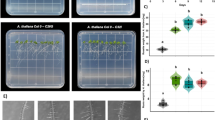Abstract
Our previous study revealed that, when exposed to light from below, fruit-bodies of humus-borne agarics grow straight downward both in the ‘Coprinus Type’ and ’Non-Coprinus Type’ species and that, in the latter, gills tilt by gravitropism, caps swell and wave, and stipes twist. The present study revealed that fruit-bodies of some lignicolous agarics also grew straight downward. Among themFlammulina velutipes andHypsizygus marmoreus fruit-bodies showed almost the same behaviour as the ‘Non-Coprinus Type’, butPleurotus ostreatus (assumedPolyporus Type) fruit-bodies did not show the gill tilting and cap waving. Rather, it redifferentiated to produce new gills or new fruit-bodies, possibly by gravimorphogenesis, or formed spiral stipes. Based on these results, graviresponses in hymenomycetes are overviewed.
Similar content being viewed by others
Literature cited
Bandoni, R. J. and Johri, B. N. 1972.Tilletiaria: a new genus in the Ustilaginales. Can. J. Bot.50: 39–43.
Buller, A. H. R. 1909. Researches on fungi, vol. 1. Longmans, Green and Co., London.
Buller, A. H. R. 1922. Researches on fungi, vol. 2. Longmans, Green and Co., London.
Butler, G. M. and Wood, A. E. 1988. Effects of environmental factors on basidiome development in the resupinate polyporePhellinus contiguus. Trans. Br. Mycol. Soc.90: 75–83.
Gorovoj, L. F., Kasatkina, T. B. and Klyushkina, N. S. 1987. [Role of gravitation in the development of carpophores in hymenomycetes.] (In Russian.) Mikol. Fitopatol.21: 301–307. (Cited in Moore, 1991).
Gorovoj, L. F., Kasatkina, T. B. and Laurinavichius, R. S. 1989. [Morphogenesis of mushrooms in changed gravitation conditions.] (In Russian.) Report of the N. G. Kholodny Institute of Botany, Academy of Sciences of the Ukrainian SSR. (Cited in Moore, 1991).
Hasselbring, H. 1907. Gravity as a form-stimulus in fungi. Bot. Gaz.43: 251–258.
Hilber, O. 1978. Biosystematische Untersuchungen zur Kenntnis vonPleurotus sect.Pleurotus. Z. Mykol.44: 31–50.
Ingold, C. T. 1953. Dispersal in fungi. Clarendon Press, Oxford.
Kaneko, A. 2001. Application of the equilibrium concept to the development of agaric fruit-bodies, with special reference to their straight downward growth in light from below Mycoscience42: 75–82.
Kaneko, A. and Sagara, N. 2001. Responses of agaric fruitbodies to light and gravity: growth straight downward in response to light from below. Mycoscience42: 67–74.
Kasatkina, T. B., Zharikova, G. G., Rubin, A. B. and Palmbach, L. R. 1984. [Development of higher fungi under conditions of weightlessness.] In: [Biological Studies on the Salyut Orbital Stations], pp. 46–49. Nauka, Moscow. (In Russian.) (Cited in Moore, 1991).
Kern, V. D. and Hock, B. 1996. Gravimorphogenesis and ultrastructure of the fungusFlammulina velutipes grown in space, on clinostats and under hyper-g conditions. Adv. Space Res.17: 183–186.
Kinugawa, K., Takamatsu, Y., Suzuki, A., Tanaka, K. and Kondo, N. 1986. Effects of concentrated carbon dioxide on the fruiting of several cultivated basidiomycetes. Trans. Mycol. Soc. Japan27 327–340.
Miller, O. Jr. 1973. Mushrooms of North America. E. P. Dutton & Co., Inc. New York.
Moore, D. 1991. Perception and response to gravity in higher fungi—a critical appraisal. New Phytol.117: 3–23.
Moser, M. 1967. Basidiomyceten II. Die Röhrlinge und Blätterpilze (Agaricales). Gustav Fischer Verlag, Stuttgart.
Pegler, D. N. 1983. The genusLentinus, a world monograph. Kew Bull. Add. Ser.10: 1–281.
Plunkett, B. E. 1961. The change of tropism inPolyporus brumalis stipes and the effect of directional stimuli on pileus differentiation. Ann. Bot. [N. S.]25: 206–223.
Sachs, J. 1865. Handbuch der Experimentalphysiologie der Pflanzen. Engelman Leipzig.
Sachs, J. 1877. Lectures on the physiology of plants. Clarendon Press, Oxford.
Schmitz, J. 1842. Mycologische Beobachtungen, als Beiträge zur Lebens- und Entwickelungsgeschichte einiger Schwämme aus der Klasse der Gastromyceten und Hymenomyceten. Linnaea16: 141–215.
Schmitz, J. 1843. Beiträge zur Anatomie und Physiologie der Schwämme. I–IV. Linnaea17: 415–548.
Singer, R. 1986. The Agaricales in modern taxonomy. 4th ed. Koeltz Scientific Books, Königstein.
Zharikova, G. G., Rubin, A. B. and Nemchinov, A. V. 1977. Effects of weightlessness, space orientation and light on geotropism and the formation of fruit bodies in higher fungi. Life Sci. Space Res.15: 291–294.
Author information
Authors and Affiliations
About this article
Cite this article
Kaneko, A., Sagara, N. Responses of lignicolous-agaric fruit-bodies to light and gravity: A study to overview the fruit-body development in hymenomycetes. Mycoscience 42, 301–310 (2001). https://doi.org/10.1007/BF02463923
Received:
Accepted:
Issue Date:
DOI: https://doi.org/10.1007/BF02463923




